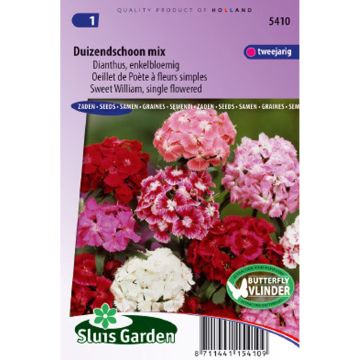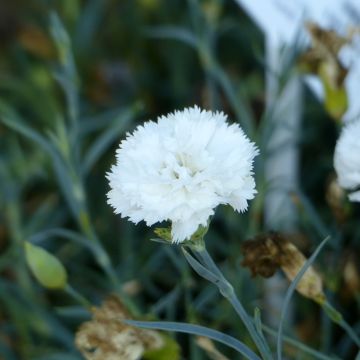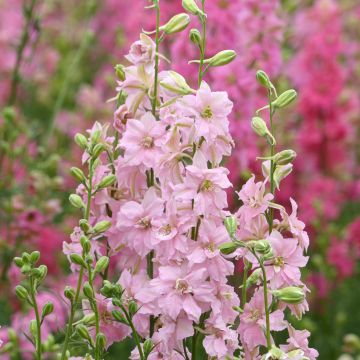

Dianthus caryophyllus Benigna
Dianthus caryophyllus Benigna
Dianthus caryophyllus Benigna
Carnation, Clove Pink
This item cannot be shipped to the selected country
Dispatch by letter from €3.90
More information
Schedule delivery date,
and select date in basket
This plant carries a 6 months recovery warranty
More information
We guarantee the quality of our plants for a full growing cycle, and will replace at our expense any plant that fails to recover under normal climatic and planting conditions.
Seed-only orders are dispatched by sealed envelope. The delivery charge for seed-only orders is €3.90.
Does this plant fit my garden?
Set up your Plantfit profile →
Description
The 'Chabaud Benigna' Florist's Carnation is an old French variety of Dianthus caryophyllus. Its white flowers edged with pink, with a distinctive clove fragrance, are double and large. They bloom in summer on top of long 80 cm stems, perfect for creating elegant bouquets. Ideal for borders and flowerbeds, these plants tolerate drought and limestone, but will flower more with regular watering.
The 'Chabaud Benigna' Florist's Carnation belongs to the caryophyllaceae family. It is an old French variety dating back to 1904. The species, Dianthus caryophyllus, is a Mediterranean plant that has passed down to its descendants, among other things, its wonderful recognizable clove fragrance. The growth of these 'Chabaud Benigna' carnations is quite fast, and the plants stand out for their vigor and floriferousness. They will reach an adult height of approximately 80 cm, with a spread of 50 to 60 cm. These carnations form dense clumps, from which fragrant flowers emerge from June to July, and continue until September if the soil remains moist, on top of long and sturdy stems, usually with a single flower. The linear, glabrous, leathery leaves are a beautiful grey-blue colour and remains evergreen throughout winter.
The 'Chabaud Benigna' Dianthus is a plant for sunny flowerbeds that combines strength, frugality, and delicacy. Placed near the house, it releases its sweet fragrance, and even more so when used in bouquets inside the house, especially because this variety is highly fragrant. In the garden, it pairs well with other flowering cushions such as rock roses, silenes, bellflowers, Erigeron karvinskianus, and Bloody Cranesbill (Geranium sanguineum). Also consider Catmints, Columbines, and Scabious. Add some clumps of ornamental grasses. These plants also adapt well to container gardening, as long as there is proper drainage and watering, with occasional fertiliser application.
Report an error about the product description
Flowering
Foliage
Plant habit
Botanical data
Dianthus
caryophyllus
Benigna
Caryophyllaceae
Carnation, Clove Pink
Cultivar or hybrid
Other Dianthus seeds
Planting and care
Sow the Sweet William seeds from February to April under cover.
Sow in trays, seedling trays or pots filled with well-drained specialized seed compost. The seeds should be barely covered with compost. Place the seedlings in a propagator, a mini-greenhouse, or a warm location to maintain an optimal temperature of 18 to 20°C. Germination usually takes 14 to 30 days.
Transplant the young plants, when they are large enough to handle, into individual pots with a diameter of 8 cm. Gradually acclimate the young plants to outdoor conditions. Space the plants with a distance of 30 cm between each plant.
You can also directly sow in open ground from April to June in a warmed soil.
Cultivation:
Plant Sweet Williams in ordinary, permeable and humus-bearing, rocky, preferably limestone, well-drained soil. Rich and light soil yields good results. In open ground, this plant shows some hardiness, withstanding temperatures as low as -15°C. It prefers a very sunny exposure. Lightly prune the plant after summer flowering to encourage a second bloom in September. In rich soil, trim some of the foliage with shears after flowering to maintain a dense habit. In poor soil, it is useful to apply a balanced fertilizer in March. It is recommended to divide the clumps every 3 years to rejuvenate those with bare bases or easily propagate through layering or cuttings.
Sowing period
Intended location
This item has not been reviewed yet - be the first to leave a review about it.
Flower seeds
Haven't found what you were looking for?
Hardiness is the lowest winter temperature a plant can endure without suffering serious damage or even dying. However, hardiness is affected by location (a sheltered area, such as a patio), protection (winter cover) and soil type (hardiness is improved by well-drained soil).

Photo Sharing Terms & Conditions
In order to encourage gardeners to interact and share their experiences, Promesse de fleurs offers various media enabling content to be uploaded onto its Site - in particular via the ‘Photo sharing’ module.
The User agrees to refrain from:
- Posting any content that is illegal, prejudicial, insulting, racist, inciteful to hatred, revisionist, contrary to public decency, that infringes on privacy or on the privacy rights of third parties, in particular the publicity rights of persons and goods, intellectual property rights, or the right to privacy.
- Submitting content on behalf of a third party;
- Impersonate the identity of a third party and/or publish any personal information about a third party;
In general, the User undertakes to refrain from any unethical behaviour.
All Content (in particular text, comments, files, images, photos, videos, creative works, etc.), which may be subject to property or intellectual property rights, image or other private rights, shall remain the property of the User, subject to the limited rights granted by the terms of the licence granted by Promesse de fleurs as stated below. Users are at liberty to publish or not to publish such Content on the Site, notably via the ‘Photo Sharing’ facility, and accept that this Content shall be made public and freely accessible, notably on the Internet.
Users further acknowledge, undertake to have ,and guarantee that they hold all necessary rights and permissions to publish such material on the Site, in particular with regard to the legislation in force pertaining to any privacy, property, intellectual property, image, or contractual rights, or rights of any other nature. By publishing such Content on the Site, Users acknowledge accepting full liability as publishers of the Content within the meaning of the law, and grant Promesse de fleurs, free of charge, an inclusive, worldwide licence for the said Content for the entire duration of its publication, including all reproduction, representation, up/downloading, displaying, performing, transmission, and storage rights.
Users also grant permission for their name to be linked to the Content and accept that this link may not always be made available.
By engaging in posting material, Users consent to their Content becoming automatically accessible on the Internet, in particular on other sites and/or blogs and/or web pages of the Promesse de fleurs site, including in particular social pages and the Promesse de fleurs catalogue.
Users may secure the removal of entrusted content free of charge by issuing a simple request via our contact form.
The flowering period indicated on our website applies to countries and regions located in USDA zone 8 (France, the United Kingdom, Ireland, the Netherlands, etc.)
It will vary according to where you live:
- In zones 9 to 10 (Italy, Spain, Greece, etc.), flowering will occur about 2 to 4 weeks earlier.
- In zones 6 to 7 (Germany, Poland, Slovenia, and lower mountainous regions), flowering will be delayed by 2 to 3 weeks.
- In zone 5 (Central Europe, Scandinavia), blooming will be delayed by 3 to 5 weeks.
In temperate climates, pruning of spring-flowering shrubs (forsythia, spireas, etc.) should be done just after flowering.
Pruning of summer-flowering shrubs (Indian Lilac, Perovskia, etc.) can be done in winter or spring.
In cold regions as well as with frost-sensitive plants, avoid pruning too early when severe frosts may still occur.
The planting period indicated on our website applies to countries and regions located in USDA zone 8 (France, United Kingdom, Ireland, Netherlands).
It will vary according to where you live:
- In Mediterranean zones (Marseille, Madrid, Milan, etc.), autumn and winter are the best planting periods.
- In continental zones (Strasbourg, Munich, Vienna, etc.), delay planting by 2 to 3 weeks in spring and bring it forward by 2 to 4 weeks in autumn.
- In mountainous regions (the Alps, Pyrenees, Carpathians, etc.), it is best to plant in late spring (May-June) or late summer (August-September).
The harvesting period indicated on our website applies to countries and regions in USDA zone 8 (France, England, Ireland, the Netherlands).
In colder areas (Scandinavia, Poland, Austria...) fruit and vegetable harvests are likely to be delayed by 3-4 weeks.
In warmer areas (Italy, Spain, Greece, etc.), harvesting will probably take place earlier, depending on weather conditions.
The sowing periods indicated on our website apply to countries and regions within USDA Zone 8 (France, UK, Ireland, Netherlands).
In colder areas (Scandinavia, Poland, Austria...), delay any outdoor sowing by 3-4 weeks, or sow under glass.
In warmer climes (Italy, Spain, Greece, etc.), bring outdoor sowing forward by a few weeks.
























































